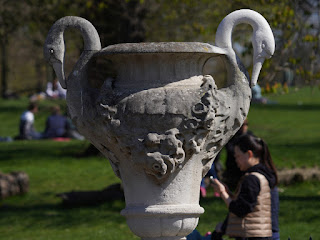The Mistle Thrushes near the Round Pond were hopping around in the grass ...
... collecting worms for their chicks.
A Starling near the Queen's Temple found a larva ...
... and within seconds, a small spider.
There is a small flock of Blackcaps in a bramble patch near the southwest corner of the leaf yard, where they can often be heard singing.
A Chiffchaff sang in an Italian alder tree on Buck Hill.
A few yards away a pair of Stock Doves perched together on a branch.
A pair of Magpies were building a nest beside the Long Water.
These large messy nests are strong and are often reused by other birds. The Hobbies and Sparrowhawks that nested in Hyde Park last year both used old Magpie nests.
Two pleasing pictures by Mark: a Blue Tit feeding on his hand ...
... and a female Chaffinch.
This is one of a pair of Lesser Black-Backed Gulls that seem to have taken up residence at Peter Pan. Both have deep yellow legs almost as intensely coloured as those of the pigeon-eating gull on the Serpentine. I think this is a sign of an efficient hunter with a lot of meat in its diet.
There was the first clear view of the Coot chicks on the Long Water near Peter Pan being fed by their parents.
A pair of Mute Swans mated on the Serpentine. A Coot was shocked by the spectacle.
I thought the swan trying to nest by the terrace of the Lido restaurant had given up, but she was back today ignoring the Easter crowds.
One of the swan-headed vases in the Italian Garden had lost a head, but the park people seem to have a spare left over from the restoration of the garden a few years ago.
An American oak near the Italian Garden fell down in the night -- strange because it withstood the recent high winds and there was little wind last night. The roots were quite rotten and there was a smell of fungus.
Tom was at Rainham. where he got good pictures of a Great White Egret flying ...
... and a Weasel looking out of the reeds.














I never pictured Coots like the decorous kind.
ReplyDeleteAlways a treat to be able to see Mistle Thrushes from so close. They are so hard to see here.
At first I read, wrongly, "A Chiffchaff sang in Italian" and had to do a double take! Now I wonder if there are different Chiffchaff dialects just as there are different dialects in many songbirds.
Indeed there are Chiffchaff dialects, and four races of Phylloscopus collybita. Ours is the nominate race P.c. collybita. There are also abientinus in northern Europe, lorenzii the Caucasian Chiffchaff, and tristis the Siberian Chiffchaff, and there is excitement among serious birders when the distinctive voice of a tristis is heard in Britain.
Delete